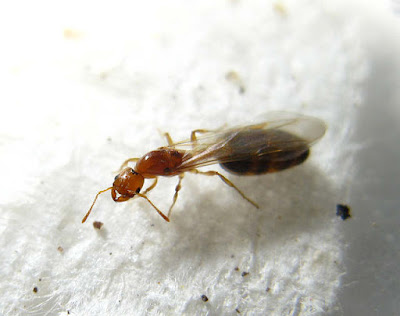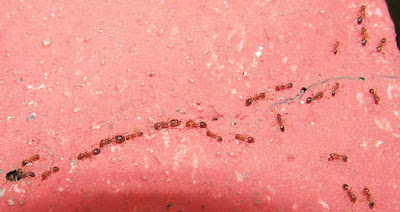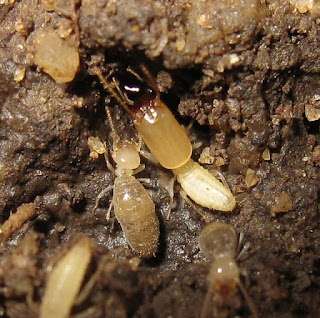Monomorium destructor has been updated to its senior synonym Trichomyrmex destructor (Jerdon 1851) This species is polymorphic having four main morphological expressions in its worker caste. Trichomyrmex destructor is also polygynous. It is a serious pest pest species with colonies causing serious damages to food stores.
Workers of Trichomyhrmex destructor. Below are the median worker and the lesser and the larger major workers missing is the minor worker.
A major worker of Trichomyhrmex destructor.
Workers of Trichomyhrmex destructor showing the four main morphological expression of the caste, two larger majors, a few lesser majors, a few medians and one minor worker.
Workers of Trichomyhrmex destructor showing the four morphological expression of the caste.
Workers of Trichomyhrmex destructor showing the four morphological expression of the caste.
Workers of Trichomyhrmex destructor.
Workers of Monomorium destructor.
Workers of Trichomyhrmex destructor.
Major, median and minor workers of Trichomyhrmex destructor.
A minor worker of Trichomyhrmex destructor.
Worker of Trichomyhrmex destructor.
Worker of Trichomyhrmex destructor.
Queen
Queen
Queen
Foundess queen with her first brood of workers
Trichomyrmex destructor nesting inside cracks and gaps of concrete walls
Passive Aggression
Trichomyrmex destructor workers strategically placing themselves all over a site to drive off Tapinoma melanocephalum from nesting in cracks of the same wall not far (around 40 centimeter) from where their nest.
In this manner without actually attacking the Tapinoma they were able to drive them off. I caught this a little late and the main confrontation had already dissipated leaving just a small area (about a third) of the initial confrontation coverage and density by the time it took me to retrieve my camera from my residence and rushed down to take this shot. By the time I got back the Tapinoma had already mostly retreated and the Trichomyrmex coverage over the area was no longer as dense and only a third of the initial.
A close up of the left over confrontation.
Here Trichomyrmex destructor managed to drive off Carebara (Pheidologeton) ssp workers from a food find with the same passive-aggression strategy. Their strategy seems to be if they are attacked then only they attack back, biting and stinging. Solenopsis geminata too deploy a similar passive-aggressive strategy (they raise the gaster and secrete a tiny drop of venom) to protect and drive off other ants from their food find.
Taxonomy:
No rank: cellular organisms 131567
Superkingdom (Domain): Eukaryota 2759
No rank: Opisthokonta 33154
Kingdom: Metazoa 33208
No rank: Eumetazoa 6072
No rank (Subkingdom): Bilateria 33213
No rank (Branch): Protostomia 33317
No rank (Infrakingdom): Ecdysozoa
No rank (Superphylum): Panarthropoda 88770
Phylum: Arthropoda 6656
No rank (Subphylum): Mandibulata 197563
No rank: Pancrustacea 197562
Subphylum (Epiclass): Hexapoda 6960
Class: Insecta 50557
No rank (Subclass): Dicondylia 85512
Subclass (Infraclass): Pterygota 7496
Infraclass: Neoptera 33340
Cohort: Holometabola
Order: Hymenoptera 7399
Suborder Apocrita 7400
Infraorder: Aculeata 7434
Superfamily: Formicoidea
Family: Formicidae 36668
Subfamily: Myrmicinae 34695
Tribe: Solenopsidini 144017
Genus: Trichomyrmex 1652995
Species: destructor 369170
Last Updated: 2021 09 03
First Posted: 2012 04 24
First Posted: 2012 04 24
© 2009 – 2021 Quah. All rights reserved.
















































































